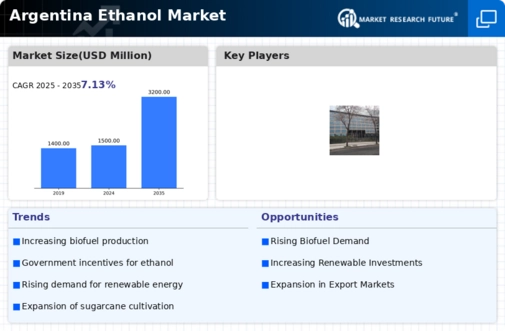The ethanol market in Argentina is characterized by a competitive landscape that is increasingly shaped by innovation, sustainability, and strategic partnerships. Key players such as Bio4 (AR), Cargill (AR), and Pampa Energía (AR) are actively pursuing strategies that emphasize operational efficiency and market expansion. Bio4 (AR) has positioned itself as a leader in biofuel production, focusing on sustainable practices and technological advancements to enhance production efficiency. Cargill (AR), with its extensive supply chain capabilities, appears to be leveraging its global presence to optimize local operations, thereby strengthening its market position. Pampa Energía (AR) is also notable for its investments in renewable energy, which align with the growing demand for sustainable fuel alternatives, indicating a collective shift towards environmentally responsible practices among these companies.
The business tactics employed by these companies reflect a moderately fragmented market structure, where localized manufacturing and supply chain optimization are pivotal. The competitive dynamics suggest that while individual companies maintain distinct operational focuses, their collective influence is shaping a more integrated market environment. This is particularly evident in the way these firms are adapting to regulatory changes and consumer preferences, which increasingly favor sustainable and locally sourced products.
In November 2025, Bio4 (AR) announced a partnership with a local agricultural cooperative to enhance its feedstock supply chain. This strategic move is likely to bolster Bio4's production capabilities while ensuring a more sustainable sourcing of raw materials. By collaborating with local farmers, Bio4 (AR) not only secures its supply chain but also supports local economies, which may enhance its brand reputation and market share.
In October 2025, Cargill (AR) unveiled a new digital platform aimed at optimizing its ethanol production processes. This initiative appears to be a significant step towards integrating advanced technologies into its operations, potentially leading to increased efficiency and reduced operational costs. The emphasis on digital transformation suggests that Cargill (AR) is keen on maintaining a competitive edge in a rapidly evolving market landscape.
In September 2025, Pampa Energía (AR) expanded its renewable energy portfolio by acquiring a stake in a bioethanol production facility. This acquisition is indicative of Pampa Energía's commitment to diversifying its energy sources and enhancing its sustainability profile. By investing in bioethanol, the company is likely positioning itself to capitalize on the growing demand for renewable energy solutions, which could yield long-term benefits in terms of market competitiveness.
As of December 2025, the competitive trends in the ethanol market are increasingly defined by digitalization, sustainability, and strategic alliances. Companies are forming partnerships to enhance their operational capabilities and meet the evolving demands of consumers and regulators alike. The shift from price-based competition to a focus on innovation, technology, and supply chain reliability is becoming more pronounced. This evolution suggests that future competitive differentiation will hinge on the ability to adapt to these trends, with companies that prioritize sustainability and technological integration likely to emerge as leaders in the market.












Leave a Comment